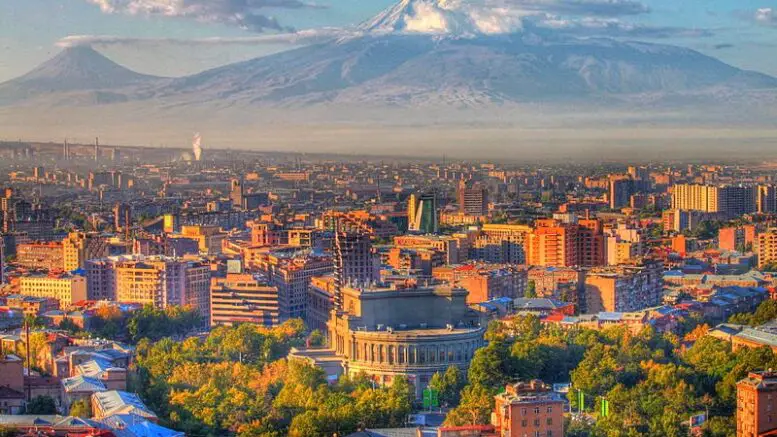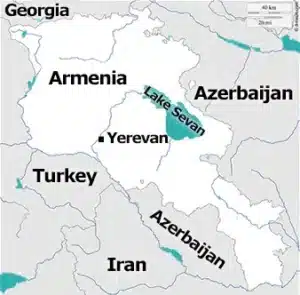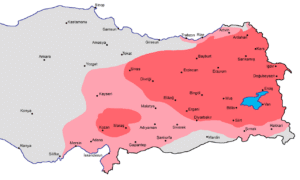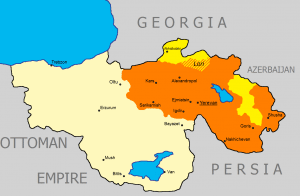The Modern Republic of Armenia lies in the turbulent south Caucuses. Although the Armenians as a people have existed for thousands of years, they have known the safety of living within peaceful and independent borders at only brief times. In fact, the Armenians have long lived between larger, warring powers and as minorities within larger empires. Because of this, they have developed into an exceedingly mobile people; the vast majority of Armenians does not live in Armenia, but rather is scattered across the globe.
That the Armenians have maintained a distinct culture despite geographic distances and despite having absorbed so many influences from so many diverse and often dominating cultures is remarkable. It is a feat they have achieved through pride in their language, religious faith, and mountainous homeland.
Today’s Armenia continues to be affected by international issues and border disputes, but is also helped by its geostrategic position and by its generous ethnic diaspora which helps support it.
Introduction to Armenia: Geohistory
Armenia is a mountainous, landlocked country slightly smaller than the US state of Maryland. The majority of its population and irrigated agricultural land are concentrated around its south western border, with Yerevan at its center. More than a third of the country’s three-million strong population lives in the capital. The mountains, which make up the majority of the country, are sparsely populated and offer small mineral deposits such as copper, gold, and molybdenum. The main cash crop is grapes, which feeds the nation’s famed cognac, wine, and brandy production. However, most of the country’s main industries, including tobacco processing, diamond cutting, and energy production (nuclear and gas), rely on imported raw materials for processing.
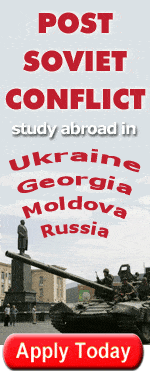
Armenia’s farmland is fed by rivers that run to the Aras River, which flows between Armenia and Turkey and into Azerbaijan. Both Turkey and Azerbaijan are currently imposing a military blockade on Armenia due to the Nagorno-Kabarakh conflict, making the river essentially useless in terms of transportation for Armenia.
Armenia’s dominant feature is Lake Sevan, a massive, natural fresh water lake that also provides irrigation waters as well as fish, recreation, and tourism.
Much of what Armenian culture considers its traditional heartland is today located in Turkey. This includes large amounts of agricultural land and Mount Ararat. This mountain is visible from Yerevan, featured in the center of Armenia’s coat of arms, and the home of the pantheon of gods whose stories are told in Armenian mythology.
Successive invasions and occupations of Armenia by foreign powers encouraged pockets of Armenians to form and move around the area. Due largely to Soviet planning, not all of these pockets were included in the Armenian SSR and thus are not included in today’s Armenia, which retains the same borders.

This map detail shows the dominance of Lake Sevan and the Caucuses in Armenia’s landscape. Transport through much of the country is difficult.
Due to conflicts with its neighbors, Armenia’s only open borders lie with Iran and Georgia, the latter providing the country’s only rail link for freight shipments. That rail, however, also passes through Abkhazia, an unrecognized republic that broke from Georgia and closed its borders with Georgia. So, freight in and out of Armenia usually travels through Georgia’s Black Sea ports in a relatively expensive and inefficient process. Through Georgia, Armenia also receives nearly all of its gas needs via a pipeline from Russia.
Perhaps because of its largely non-functioning borders, Armenia has been forced to rapidly develop a services industry, particularly in IT services, to allow its economy to continue to function. As of 2021, services made up about 53% of the economy, more than any other sector (with mining taking 27% and agriculture 10%). Much of the investment and construction needed to make this happen (and to develop Nagorno-Karabakh), is financed through remittances and investments made by the sizeable populations of Armenians living in Russia and the US.
For more on Armenia’s foreign policy and security imperatives, click here.
Armenia from Pre-history to the Early 1800s
The Armenians are an inherently international people. Most scholars agree that they likely originated in South Eastern Europe, then migrated to the Caucuses where they mixed linguistically, culturally, and/or genetically with various Caucasian groups as well as various other groups that would later conquer what became the Armenian homelands: Persians, Turks, Greeks, Romans, and, later, the Russians.
Armenians call their country “Hayk” and refer to themselves as “Hayer.” The legend of Hayk, a hero from ca 2500 BC, is told by the 5th century Armenian historian Movses Khorenatsi. Hayk left Babylon (today a city in Iraq and long a major part in Middle Eastern empires) due to the oppressive King Titanid Bel. Hayk settled with his kinsmen at the foot of Mt. Ararat. Hayk named his settlement Haykashen and later killed Titanid Bel in battle. Hayk had a son, Aram, whose name is the root of the exonym Armenia. Armenian tradition traces the heritage of all Armenians back to this family of heroes.
The name “Armenia” was most often used in ancient Persian and Greek sources and thus is still most commonly used in the Western world to refer to the country.
A documentary on Armenia focusing on history and travel.
For centuries after Hayk, the Armenians lived under various rulers including the Hittites and, most importantly, the Kingdom of Urartu (860-590 BCE), from which the Armenians adopted a pantheon of gods, elements of the Armenian language, and began to solidify as a cultural and political entity. Urartu, named for Mount Ararat which sat at its center, is often pointed to by Armenian nationalists as a pivotal time for the formation of the eventual Kingdom Armenia.
That kingdom first gained independence with the fall of the Seleucid Empire. The Seleucid Empire was a Hellenic state formed from lands originally conquered by Alexander the Great. The Armenian language and culture were deeply influenced by the Seleucids, under whom Armenians served as local rulers. When the Seleucids crumbled under Roman pressure, the Kingdom of Armenia was recognized by Rome an independent political force in 190 BCE.
The Kingdom of Armenia briefly became an empire under Tigranes the Great in the final century BCE. At its height, the Empire covered present day Armenia, parts of Georgia and Azerbaijan, Iran and Iraq, and stretched southwest across Turkey to Syria and the Mediterranean Sea. Tigranes was eventually conquered by Rome, however, in 55 BC and his former Kingdom would spend the next 500 years as a contested border province between Rome and the successive Middle Eastern empires. Because of Tigranes’ ambitious expansion, however, ethnic Armenians migrated throughout the area, most notably the region of Cilicia on the coast of the Mediterranean in what is today south eastern Turkey.
In the late Roman period, Armenia became the first country in the world to formally adopt Christianity as its state religion when King Tiridates III of Armenia converted in 301 AD. This predated the Roman religious tolerance edicts from Galerius and Constantine by 10 and 12 years respectively. That Armenia was first and that it managed to retain its Christianity throughout the centuries despite being surrounded by majority Muslim populations is a key element to Armenian identity today. The Armenian Apostolic Church remains a major cultural influence among the Armenian people. Churches are found across the globe wherever the people reside.

The Armenian Empire at its height under King Tiridates. Note the placement of the Kingdom of Cilicia at the top of the Mediterranean Sea.
Rome fell and what had been Armenia was eventually split between the Byzantines and the Persians. Persian influence on Armenia’s language and culture became pronounced during this time.
The rise of the Arab states eventually led to the Byzantine-Arab wars, which ravaged the Armenian homelands. In the chaos, the Armenians united under Ashot I in the 9th century and fought the Emirs. Although full independence was not achieved, Ashot was crowned king and granted considerable autonomy which he used to expand his lands and revitalize the Armenian economy and culture from 862-890 AD.
Armenian autonomy continued until the Arabs began to reassert power in the late 1,000s. Several splinter kingdoms formed during this time, among them the precursor to the modern territory of Nagorno-Karabakh.
Upheavals in the Caucasus over the next 300 years caused by the Byzantines and Seljuk Turks triggered mass migrations away from the Armenian’s traditional homeland south toward the Mediterranean. Many settled across Anatolia (modern day Turkey) with many ending in Cilicia, joining communities of Armenians that had settled there under Tigranes the Great over 1,000 years before. Eventually, the Armenian Kingdom of Cilicia was founded there and prospered through its relations with Western Europe and by serving as a launching site for the Crusades.
The end of Crusades, the arrival and later Islamization of the Mongols, and repeated invasions, particularly from Egypt by the Muslim Mamluks, weakened and broke the Cilician state in 1375. Many of the Armenians there again dispersed, traveling westward and settling is places such as Cyprus, Cairo, Venice, Marseilles, Paris, and Holland.
Although many Armenians migrated, many stayed. In fact, the Armenians retained a majority or significant minority in an area stretching from modern Armenia through central Turkey. Those who stayed behind, however, suffered under numerous invasions. Successive Mongol and Arab rulers ruled over the divided Armenian homeland over the following centuries. Starting in the mid-17th century, the Ottomans would rule the west and the Persians controlled the East. This would be the case until the 19th century.
Those who emigrated tended to be those with the means to so. The Armenians also tended to form cohesive Armenian communities in their new homelands, and to keep in contact with other Armenian communities elsewhere. They also, however, tended to learn the local language and to try integrate. This unique position often led the Armenian to become translators and intermediaries. The international network of Armenians that developed helped many to excel in trade. The international stereotype of the Armenian as a wily businessman reflected a genuine entrepreneurial spirit that permeated Armenian culture. It also, however, led to discrimination that closely resembled antisemitism.
Armenia under Russia and the Ottomans
Russia had been pressing towards the Caucasus Mountains for some time, seeking to give their empire a defensible southern anchor by controlling the entirety of the high mountain range. Many Armenians looked on this as an opportunity. The Russians were a Christian nation that had pledged to protect the interests of Christians everywhere. Surely living under the Russian empire would be preferable to living under a Muslim empire?
- The Ottoman conquest of Western Armenia meant that much of what is now modern eastern Turkey (shown here) was once populated by Armenian majorities. Map from Wikipedia.
- In the aftermath of WWI, Woodrow Wilson suggested joining many areas populated by Armenians under a single Armenian state. The idea was never implemented. Map from Wikipedia.
Nicholas I annexed most of what is today modern Armenia from the Persians in 1828. This sparked hope for many Armenians still living in Persia and the Ottoman Empire, and about 50,000 total immigrated into Russian Armenia. Armenia, however, was now a militarized zone bordering Russia’s rivals and it was ruled as such. Little autonomy was granted, Armenian nationalism was distrusted, and an occupying army, led by the harsh General Tsitsianov, remained to rule and defend the new possession. The Russians built the railroad from Georgia at this time to improve transportation and communication. This railroad was also a boon for the local economy, and today represents the main overland transport line out of Armenia.
There are no reliable figures to determine exact populations, but roughly over half of the world’s Armenians were estimated to be residing in the Russian-controlled territory in the mid 1800s. Another 20 to 40 percent lived in the Ottoman Empire in the eastern regions of Anatolia. The remainder was spread out to other parts of Europe or Africa.
Russian rule did give the Armenians greater access to European thought and to ideas of nationalism. Armenians in both Russia and the Ottoman Empire used the mostly peaceful second half of the 19th century to rebuild their national identity. Although they faced oscillating policies of Russification and more liberal autonomy from Moscow, the Armenians opened schools, their writers modernized the vernacular Armenian language, and the national entrepreneurial spirit was allowed to flourish in many parts of the Russian empire, including in the native Armenian lands.
The Armenian Revolutionary Federation (ARF) emerged in 1890, pressing for more autonomy from the Tsar and the Sultan alike. This nationalism was not welcomed by either Russia nor the Ottomans, and the Sultan lashed out particularly harshly. The years 1894-96 saw many Armenians arrested, tortured, and some 300,000 killed.
In the lead-up to World War I, the political structure of the Ottoman Empire shifted radically and abruptly. Although more liberal Young Turk leaders rose to power, Turkish ultranationalists soon supplanted the progressives and pushed blame on the Armenians for the problems of the aging empire.
When World War I began and the Ottomans aligned with the Central Powers, even the Young Turks viewed the Armenians as a tool of the Allies. Suspicion turned violent in late April, 1915 when deportations and executions of Armenians erupted on a massive scale. Many were forced on boats that were then sunk into the Mediterranean. Hundreds of thousands of Armenians, young and old, were forced to march from their homes and into the barren wildernesses of Syria. The death toll is estimated anywhere between 600,000 and 1.5 million, a significant portion of the Ottoman Empire’s Armenian population. Most Armenian historians and an increasing portion of the international community now cite this as history’s first modern genocide.
Some Armenians fled abroad, many to Europe or America. Armenians around the world today observe an annual day of mourning in late April, usually April 24th, the day in 1915 when many members of the Armenian intelligentsia were arrested and later executed. This has proven to bind the Armenian community even closer together despite the borders that may separate them from their homeland. Armenia has also founded an impressive Armenian Genocide Museum to memorialize and study the event.
Following World War I, Armenia experienced another short breath of autonomy when the Allies sought to give them a homeland that would incorporate much of what had been the ancient kingdom of Armenia into an independent state. This would reunite Russian and Ottoman Armenian populations for the first time in centuries. Woodrow Wilson proposed the state it is sometimes referred to as “Wilsonian Armenia.”
A video by Stratfor on the geopolitics of Armenia.
That Armenia was not to be, however. Russian Armenia did declare independence in 1918, after the Tsarist government fell. The Republic of Armenia existed for two years before the Red Army marched into Yerevan, reasserting Russian control. This, with collapse of the Ottoman Empire and the Turkish War of Independence, eventually led the US to drop the demands for Armenia from the treaty negotiations. The treaty itself went largely unratified.
Armenia under the Soviets

World War II affected Armenia the least out of the three Caucasian republics, as it did not have the oil reserves of Azerbaijan, nor the industrial capacity of Georgia (although Armenia’s industrial capacity had doubled three times over under the Soviets). The Armenian people did contribute many lives to the Great Patriotic War, with approximately 500,000 Armenians taking part and half of those not returning home. During and after WWII, the USSR practiced population redistribution on a massive scale. Armenians found in Nazi camps and some Armenians in other border regions of the USSR were moved to Central Asia and the South Caucasus, including, sometimes, to Armenia itself.
The thaw that occurred after Stalin’s death lead to more self-governance in Armenia and a revitalization of the Armenian Apostolic Church. Armenia also began to consider ways to rejoin their homelands, asking Moscow to take historically Armenian populated regions from Turkey. Later, following Glasnost in the late 1980s, the Armenian SSR sought to reclaim Karabakh and Nakhichevan through a petition to Moscow. In 1988, demonstrations for and against the petition in Armenia and Azerbaijan broke into ethnic violence, rioting, and spiraling tensions between the two republics.

This topographic map shows Azerbaijan’s effective borders before (top) and after (below) the 1993-1994 war. Note that the loss of this territory eliminates much of a defensible mountainous border that once separated it from its long-time enemy, Armenia. In a wider conflict, this would be a great advantage to Armenia, making the defense of southern Armenia easier (by eliminating a bottleneck and expanding the territory) and make the invasion of eastern Azerbaijan easier.
In December, 1988 a major earthquake hit Northern Armenia, affecting in particular the cheaply-built Soviet housing stock, leaving many homeless in the winter. The Soviets, mired in internal difficulties and a faltering economy, were slow to respond, drawing still more ire from the Armenian SSR.
A group known as Karabakh Committee developed out of growing anti-Moscow sentiment in the late 1980s, and the New Armenian Army, developed largely to defend Armenian interests from Azerbaijan, was formed 1990. As cracks began to form in the USSR, Armenia was one of the first republics to declare independence. The Communist Party peacefully transitioned power to the new leadership when the vote was finally held in 1991, and Armenia democratically elected its first president, Ter-Petrosyan, who would lead for most of the decade.
Armenia from Independence to the Present
War broke out with Azerbaijan in 1992. Although Azerbaijan had a larger military, Armenia had more officers and equipment and emerged victorious.
However, the war meant that reconstruction of the earthquake-devastated north was hindered for several more years as resources were pulled toward the war effort. Further, both Azerbaijan and its ally Turkey both closed their borders to Armenia. Food which had traditionally come from Turkey halted and oil and gas from Azerbaijan likewise stopped, disrupting the Armenian economy. A new wave of population redistribution followed, with Armenians displaced from the war flowing into Armenia, but also with many Armenians who had the means to do so seeking better economic fortunes abroad.
Like most former Soviet republics, politics in Armenia have been contentious. Armenia’s first president, Levon Ter-Petrosyan, an academic fluent in multiple languages that had led efforts to reunite Nagno-Karbakh with Armenia under the USSR, was elected with great fanfare and public support. He was then accused of rigging his 1996 reelection. Later, when he ran and lost an election, he accused his opponent of wrongdoing. Armenia has had a history of forcibly putting down protests, but despite all this, it remains in the West’s good graces and elections have generally passed OSCE inspections.
In late 2015, Armenia held a constitutional referendum that sought to shift the state from a semi-presidential system to a parliamentary one. Organized by the ruling Republican Party of Armenia (RPA) and was supported by a coalition of political parties, it passed with 63% of voters believing that it would result in a fairer, more democratic Armenia.
The president was made largely a figurehead and the prime minister gained the ability to appoint and dismiss the government, approve the budget, and oversee the work of the executive branch.
In 2018, however, Serzh Sargsyan, the president who spearheaded the reforms ran for prime minister, rather than stepping down from power peacefully as promised. It also became clear that the new electoral system created by the referendum greatly favored the ruling party.
Mass protests broke out led by opposition leader Nikol Pashinyan that led to Serzh Sargsyan’s resignation and the appointment of Pashinyan as prime minister. In December 2018, Armenia held new parliamentary elections, which were won by Pashinyan’s political party, the Civil Contract party.
While some hoped that the new government would steer Armenia in a more solidly liberal and pro-EU direction, it soon became clear that Pashinyan intended to rule solidly from the center but was also struggling to balance the interests of Armenia’s various power centers.
This came to a head in September-November 2020, when war broke out again between Armenia and Azerbaijan over the disputed region of Nagorno-Karabakh. Both countries had worked to build up their militaries since the previous war but energy-rich Azerbaijan had far outstripped Armenia in spending. Armenia was soundly defeated and in the ceasefire agreement brokered by Russia, Azerbaijan took back much of the land it lost in the first war.
This created a political crisis in Armenia, where the defense and support of Nagorno-Karabakh became a point of national pride and identity. In June 2021, snap parliamentary elections were held in Armenia, but the Civil Contract Party and Pashinyan retained their positions.
However, Paninyan was still struggling to consolidate power. In November 2021, the Armenian government declared a state of emergency and arrested several opposition politicians and activists, including former President Robert Kocharyan, on charges of attempting to stage a coup. The move was criticized by human rights groups and the international community.
Today’s Armenia faces many challenges and opportunities. Its citizens list national security and Nagorno-Karabakh has their main concern. Issues of economic security come next as issues of widespread poverty and economic emigration remain unresolved from the Soviet era. The environment is also a concern as the country hopes to tap more of its mineral resources but this could threaten water quality and the country’s plans to become a tourism center.
For more on Armenia’s foreign policy and security imperatives, click here.
Armenia on the Global Stage
Today, less than a quarter of Armenians worldwide reside in Armenia. A strong sense of ethnic and national pride means that Armenians in this large diaspora are likely to give back to their homeland, whether it be through the Armenian Apostolic Church or direct investment in local business.
Since Russia began what it calls its “special military operation”* in Ukraine, an estimated 65,000 Russians have immigrated to Armenia, or about 2% of the overall population. Although the arrival of these immigrants has led to higher inflation, particularly in Yerevan, they have also helped plug the emigration crisis and brain drain the country was facing. Further, Armenia’s trade with Russia has risen by nearly 450% since 2020 with the country becoming a hub for re-exported electronics and vehicles to Russia.
Internationally, Armenia has sought to gain international recognition of the Armenian Genocide. This effort has been gaining force, thanks in large part to the influential diaspora. The nearly half million Armenians in the US carry electoral weight and have convinced most US states to recognize the event although the federal government has not made a formal pronouncement. Russia is home to more than two million Armenians, with many of them in high profile positions – including Foreign Minister Sergei Lavrov, RT Chief Margarita Simonyan, and opposition politician Gary Kasperov. Russia officially recognized the genocide in 2015.

A map of the Armenian Diaspora. Countries shown in dark red have between 100,000 and 3,000,000.
Armenia’s economy is closely linked with Russia, with Russia being by far the country’s major trading partner. It also relies on Russia for much of its new military equipment, of which it has purchased massive amounts in recent years as an arms race has mounted with Azerbaijan. Russia also provides parts and service for many of the older Soviet-built weapons that Armenia still uses. Thus, despite the historically rocky relationship between Armenia and Russia, Armenia still sees its fortunes as tied, in many ways, to Russia. Armenia joined the Russia-led Eurasian Economic Union in 2015 to secure lower gas prices and more opportunities to export their products.
Armenia today officially retains its Soviet borders and the people of Nagorno-Karabakh declare themselves to be an autonomous republic. However, Nagorno-Karabakh is unrecognized by the international community and his been shrunk from its 1994 borders to roughly its Soviet-era borders by the most recent conflict. Peace negotiations remain unresolved. Borders with Turkey and Azerbaijan remain closed, making transport routes with Georgia and Iran essential. Armenia still tries to balance ties with Russia and the US.
As of 2023, the conflict remains hot. Armenia is in a weakened position and Azerbaijan is angling for deeper control of Nagorno Karabakh and of a corridor to its enclave of Nakhchivan through southern Armenia. With America and Russia distracted with Ukraine, Armenia currently feels that it lacks a strong international partner in its conflict. If Azerbaijan chooses to push further with its demands, it may well be successful.
With every unknown, one thing remains constant for Armenia: The men, women, and children who make up the Hayer, whether they live in Yerevan, New York, Sydney, Sao Paulo, or Moscow, each know their heritage and will proudly bear it into the coming generations.
*part of the content of GeoHistory is produced in Russia, where there are laws restrictive of what current events can be called.
More About Armenia
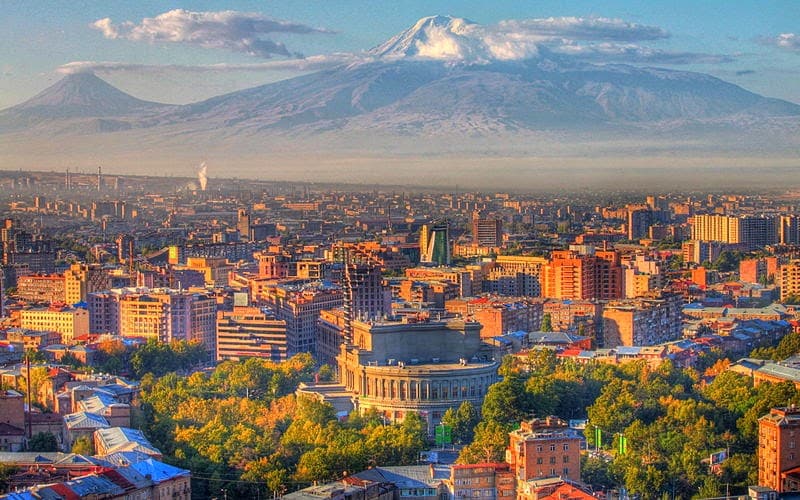
Armenia: A Global People
The Modern Republic of Armenia lies in the turbulent south Caucuses. Although the Armenians as a people have existed for thousands of years, they have…
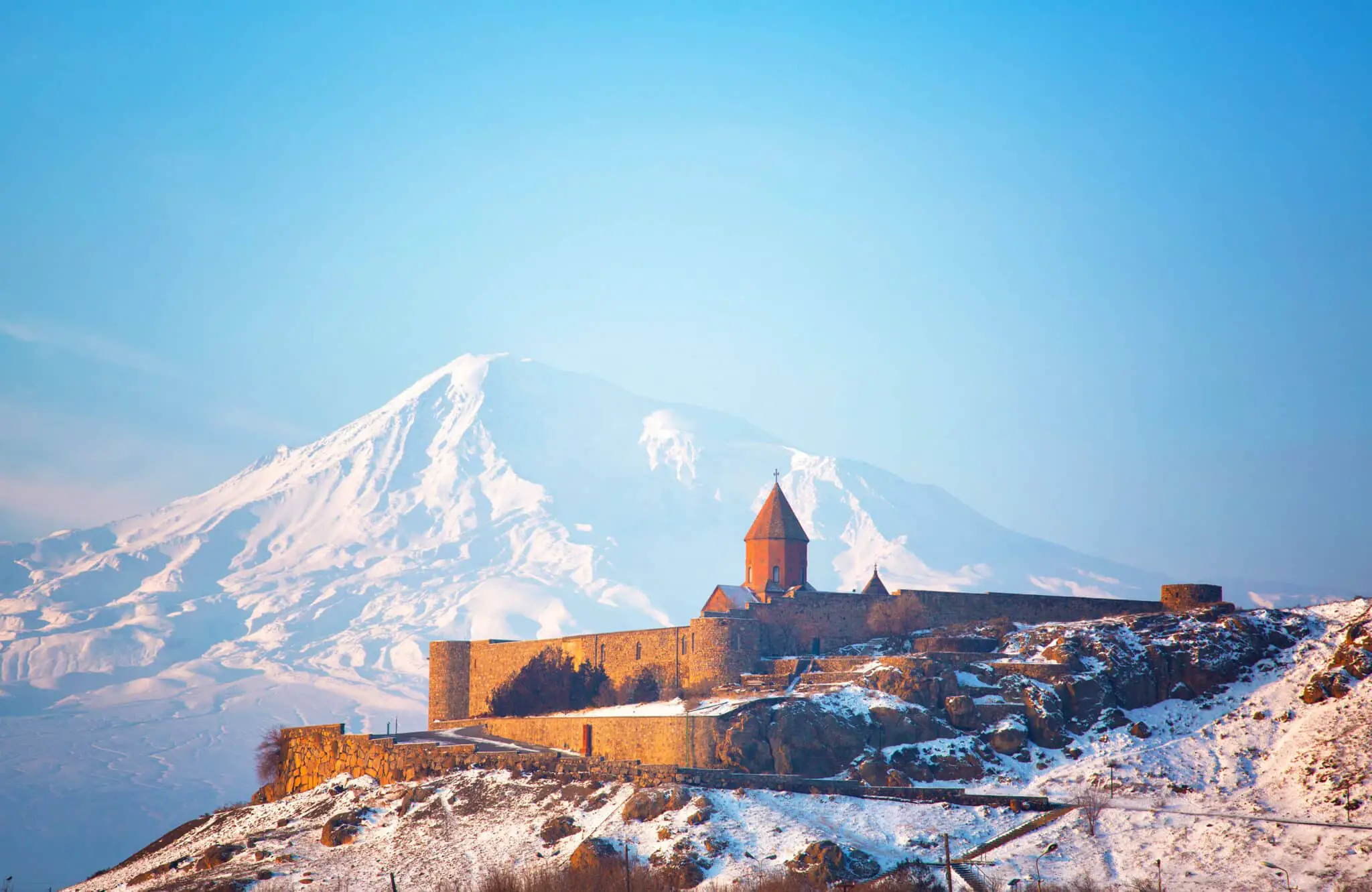
Armenia’s Foreign Policy and Security Issues for 2023
The most important issue in Armenia’s regional relations is the Nagorno-Karabakh conflict. Armenia is a landlocked country flanked by two historical adversaries, Turkey and Azerbaijan,…
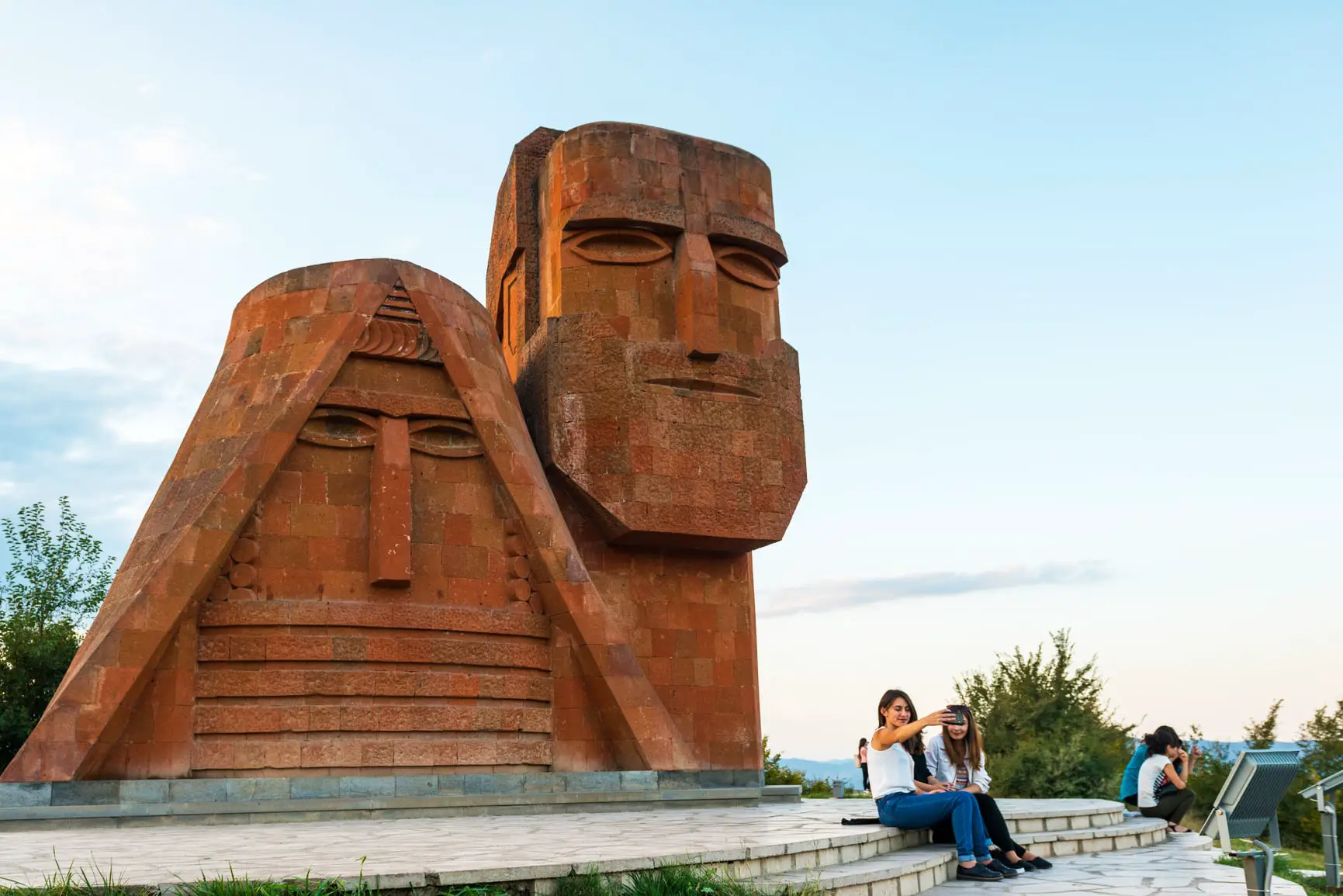
Nagorno-Karabakh: The Volatile Core of the South Caucasus
The Republic of Nagorno-Karabakh is one of four frozen conflicts that emerged after the collapse of the Soviet Union. Legally recognized as a part of…

A Comparative Look at Coronavirus Responses in Eurasia
The global health crisis has changed life around the world, but in often very different ways in various places. Even countries located close to each…
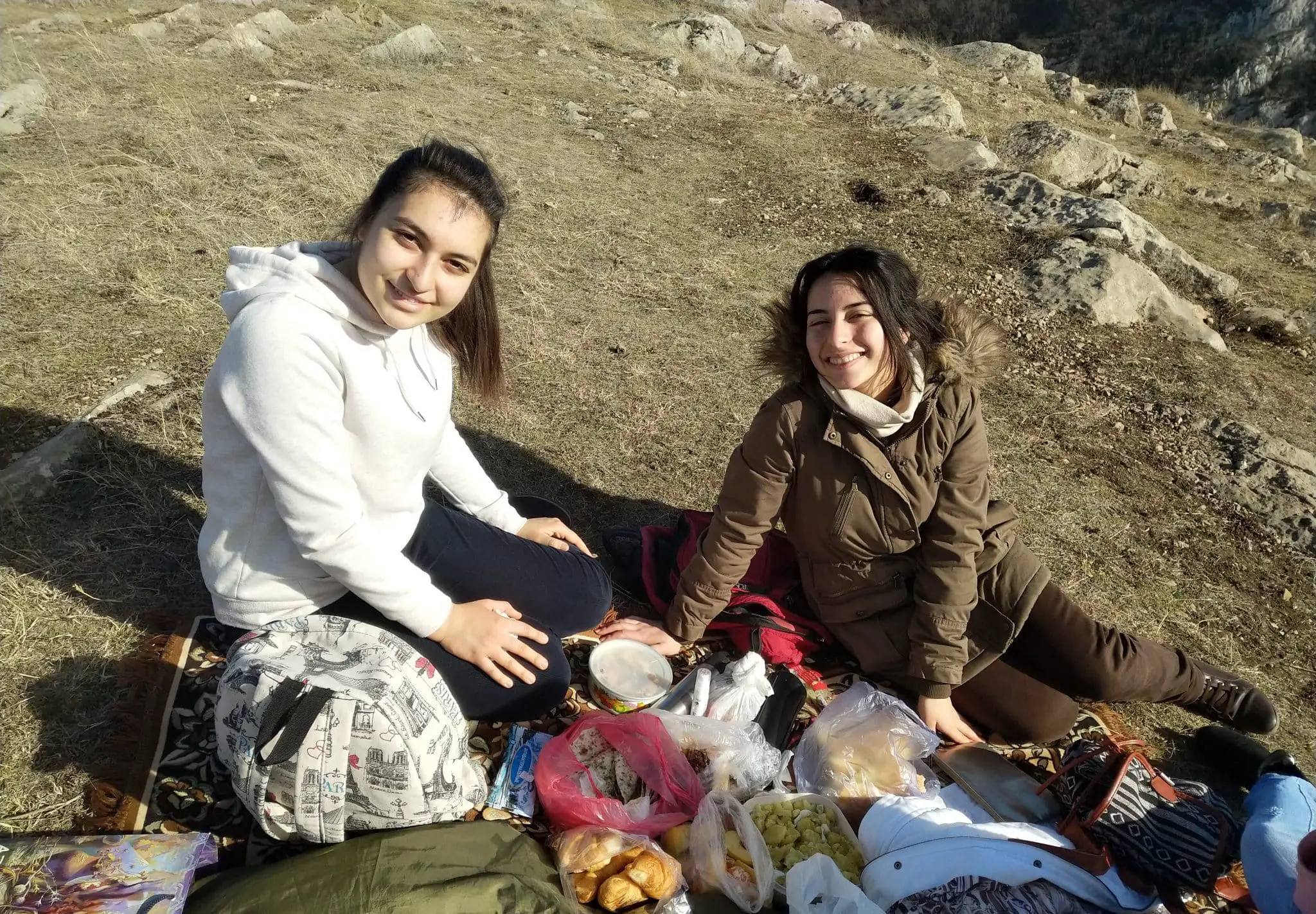
Karabakh: Youth, War Zones, and Unrecognized Borders
The views expressed in this interview do not necessarily reflect those of GeoHistory or SRAS. This fascinating interview is presented here as documentation of what…


